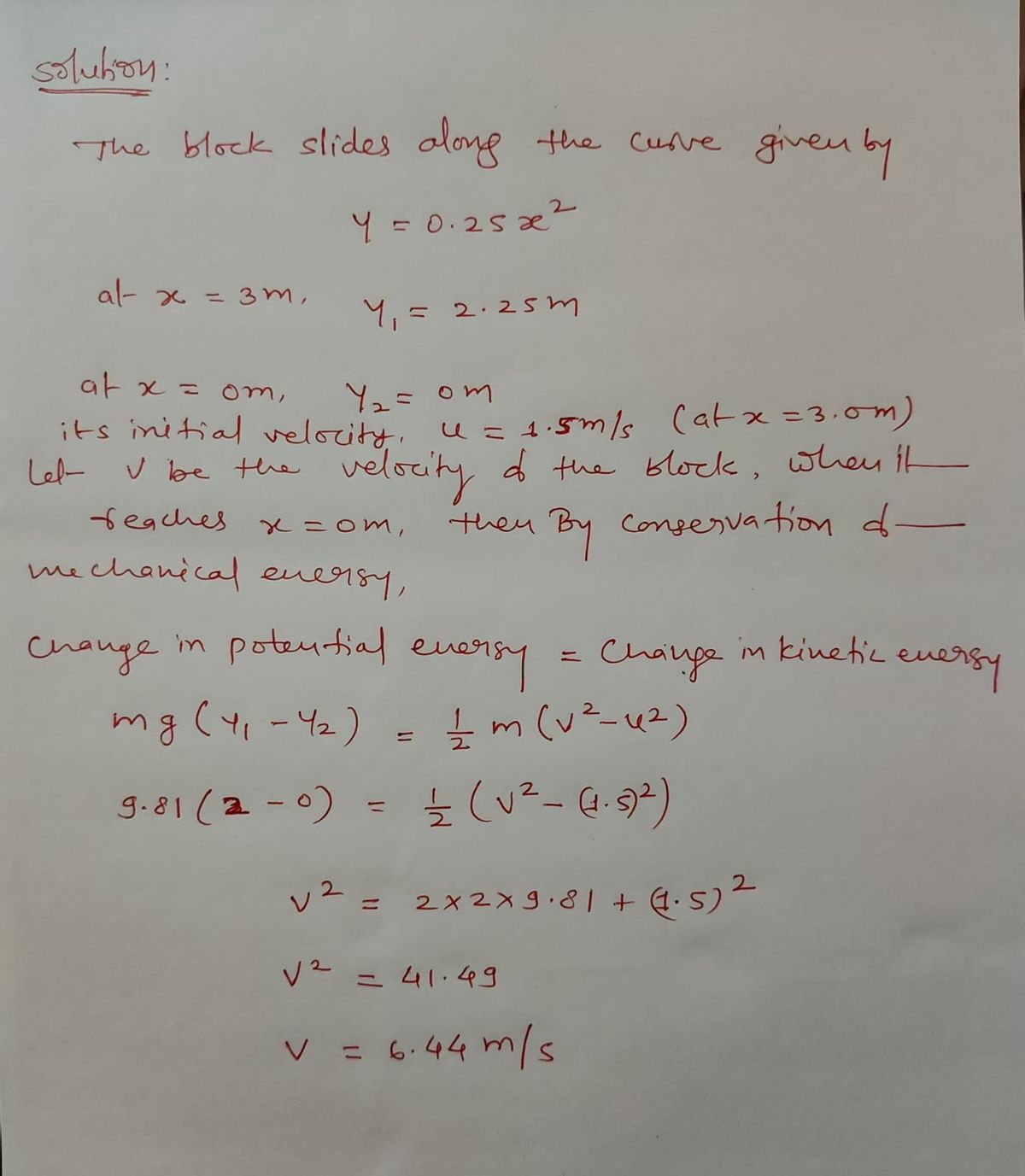3. For this series of 5 questions, a block is released from the position shown with a certain initial velocity. It then slides down the smooth (friction-less) path for which the function is given in the image. You will be asked to solve for different things. Please pay attention: the numbers may change from problem to problem since they are randomized. 2) As the block slides down, its potential energy converts into kinetic energy. If its initial velocity is 1.5 m/s (at x = 3 m), determine its velocity, v, at x = 3.0 m. Your answer must include 2 places after the decimal point and the proper unit. Take g = 9.81 m/s².
3. For this series of 5 questions, a block is released from the position shown with a certain initial velocity. It then slides down the smooth (friction-less) path for which the function is given in the image. You will be asked to solve for different things. Please pay attention: the numbers may change from problem to problem since they are randomized. 2) As the block slides down, its potential energy converts into kinetic energy. If its initial velocity is 1.5 m/s (at x = 3 m), determine its velocity, v, at x = 3.0 m. Your answer must include 2 places after the decimal point and the proper unit. Take g = 9.81 m/s².
Elements Of Electromagnetics
7th Edition
ISBN:9780190698614
Author:Sadiku, Matthew N. O.
Publisher:Sadiku, Matthew N. O.
ChapterMA: Math Assessment
Section: Chapter Questions
Problem 1.1MA
Related questions
Question
![**Problem Statement:**
3. For this series of 5 questions, a block is released from the position shown with a certain initial velocity. It then slides down the smooth (frictionless) path for which the function is given in the image. You will be asked to solve for different things. Please pay attention: *the numbers may change* from problem to problem since they are randomized.
2) As the block slides down, its potential energy converts into kinetic energy. If its initial velocity is 1.5 m/s (at \( x = 3 \) m), determine its velocity, \( v \), at \( x = 3.0 \) m. Your answer must include 2 places after the decimal point and the proper unit. Take \( g = 9.81 \text{ m/s}^2 \).
**Diagram Explanation:**
The diagram shows a block on a frictionless track. There is a horizontal spring with a spring constant \( k = 5 \) kN/m. The track follows the curve defined by the equation \( y = 0.25x^2 \). The point of interest is at \( x = 3 \) m where the initial velocity of the block is 1.5 m/s.
**Input Field:**
Your Answer: [ ] [units]
---
On an educational website, users would enter their calculated velocity and appropriate units in the provided input field.](/v2/_next/image?url=https%3A%2F%2Fcontent.bartleby.com%2Fqna-images%2Fquestion%2Fbfe9d656-8cd3-4744-b9a0-a4b8146b5e21%2F307a920d-fdd5-4082-8a94-4f4f7ce4e56c%2Fj6ji5fw_processed.jpeg&w=3840&q=75)
Transcribed Image Text:**Problem Statement:**
3. For this series of 5 questions, a block is released from the position shown with a certain initial velocity. It then slides down the smooth (frictionless) path for which the function is given in the image. You will be asked to solve for different things. Please pay attention: *the numbers may change* from problem to problem since they are randomized.
2) As the block slides down, its potential energy converts into kinetic energy. If its initial velocity is 1.5 m/s (at \( x = 3 \) m), determine its velocity, \( v \), at \( x = 3.0 \) m. Your answer must include 2 places after the decimal point and the proper unit. Take \( g = 9.81 \text{ m/s}^2 \).
**Diagram Explanation:**
The diagram shows a block on a frictionless track. There is a horizontal spring with a spring constant \( k = 5 \) kN/m. The track follows the curve defined by the equation \( y = 0.25x^2 \). The point of interest is at \( x = 3 \) m where the initial velocity of the block is 1.5 m/s.
**Input Field:**
Your Answer: [ ] [units]
---
On an educational website, users would enter their calculated velocity and appropriate units in the provided input field.
Expert Solution
Step 1

Step by step
Solved in 2 steps with 1 images

Knowledge Booster
Learn more about
Need a deep-dive on the concept behind this application? Look no further. Learn more about this topic, mechanical-engineering and related others by exploring similar questions and additional content below.Recommended textbooks for you

Elements Of Electromagnetics
Mechanical Engineering
ISBN:
9780190698614
Author:
Sadiku, Matthew N. O.
Publisher:
Oxford University Press

Mechanics of Materials (10th Edition)
Mechanical Engineering
ISBN:
9780134319650
Author:
Russell C. Hibbeler
Publisher:
PEARSON

Thermodynamics: An Engineering Approach
Mechanical Engineering
ISBN:
9781259822674
Author:
Yunus A. Cengel Dr., Michael A. Boles
Publisher:
McGraw-Hill Education

Elements Of Electromagnetics
Mechanical Engineering
ISBN:
9780190698614
Author:
Sadiku, Matthew N. O.
Publisher:
Oxford University Press

Mechanics of Materials (10th Edition)
Mechanical Engineering
ISBN:
9780134319650
Author:
Russell C. Hibbeler
Publisher:
PEARSON

Thermodynamics: An Engineering Approach
Mechanical Engineering
ISBN:
9781259822674
Author:
Yunus A. Cengel Dr., Michael A. Boles
Publisher:
McGraw-Hill Education

Control Systems Engineering
Mechanical Engineering
ISBN:
9781118170519
Author:
Norman S. Nise
Publisher:
WILEY

Mechanics of Materials (MindTap Course List)
Mechanical Engineering
ISBN:
9781337093347
Author:
Barry J. Goodno, James M. Gere
Publisher:
Cengage Learning

Engineering Mechanics: Statics
Mechanical Engineering
ISBN:
9781118807330
Author:
James L. Meriam, L. G. Kraige, J. N. Bolton
Publisher:
WILEY